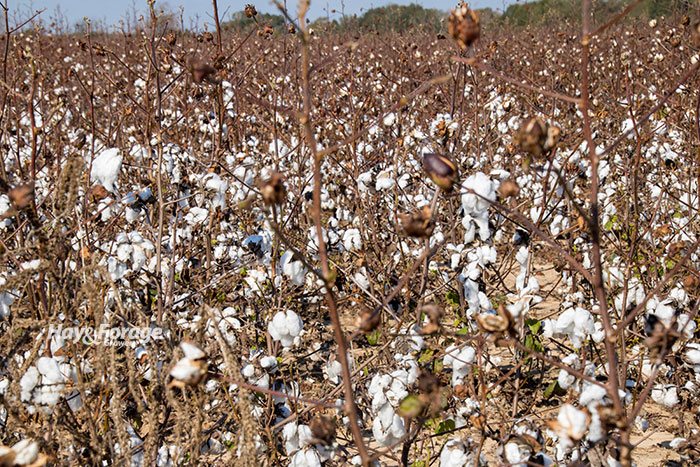
Cotton fiber may be the most valuable part of a cotton plant for human use, but cotton stalk residue can be utilized for livestock feed. Grazing cattle on leftover lint, leaves, burrs, and unopened bolls may help stretch hay supplies in the months ahead.
“Large amounts of residue are left on the plant after cotton harvest,” says Paul Beck, an extension beef nutrition specialist with Oklahoma State University. “This is an underutilized source of winter feed for dry, pregnant, spring-calving cows.”
To demonstrate this, one study in Georgia compared the results of grazing dry cows on cotton stalk residue versus feeding animals bermudagrass hay. The stocking rate in the grazing treatment was one cow per acre, and the experiment lasted approximately 44 days. Overall, cows consumed an average of 37 pounds of cotton stalk residue per day.
“The research in Georgia showed that dry, pregnant cows can be maintained on cotton stalk residue instead of bermudagrass hay with only a slight reduction in body condition,” Beck states.
In a similar study from the Peach State, researchers grazed dry cows on cotton stalk residue and provided them with free-choice hay. The stocking rate in this experiment was also one cow per acre, and animals grazed for 30 days. Data shows the cattle with access to cotton stalk residue ate 67% less hay, yet did not experience significant weight loss or lower body condition.
The edible components of the cotton stalk residue in this study — lint, leaves, burrs, bolls, and cottonseed — underwent a nutritional analysis. These materials had over 20% crude protein and 62% total digestible nutrients; however, the edible components of cotton stalk residue only make up 30% to 50% of the total residue in a field.
Evaluate residue availability
Before grazing cattle on cotton stalk residue, Beck recommends estimating a field’s carrying capacity. Identify two to three representative areas of a field after harvest and take a sample from each area by cutting cotton stalks from one row for a distance of 9 feet. Weigh the residue and calculate the area of each collection site.
For example, in a field with 36-inch rows, multiply 9 feet of collected residue by 3 feet of row space for a total area of 27 square feet. Then, divide the weight of the collected residue by the total area to find pounds of residue per square foot. If there were 3 pounds of residue in 27 square feet, there would be approximately 0.11 pounds of residue per square feet.
Next, multiply the amount of residue per square foot by 43,560, which is the number of square feet in an acre. The edible components of the cotton stalk residue will make up between 30% and 50% of this value, and this range can be used to determine stocking rates and the length of time cows can graze.
Gin trash has more ash
In addition to cotton stalk residue, cotton gin trash can also be fed to cattle. Each bale of cotton produces about 150 to 200 pounds of gin trash during the ginning process, and this material also contains leaves, burrs, boles, stems, lint, cottonseed, as well as soil.
Beck points out that gin trash is usually lower quality than cotton stalk residue, averaging 12% crude protein and 43% total digestible nutrients. While these protein levels may be adequate for dry cows, the energy levels are not. Furthermore, gin trash may be more challenging to introduce to animal diets.
“Gin trash can contain large amounts of soil contamination and is initially unpalatable to cows, which may take several days for them to adapt and begin consuming gin trash,” Beck says. “Because of the variability and unpalatability, intake should be closely monitored, and supplemental feeding should be adjusted accordingly.”

Amber Friedrichsen served as the 2021 and 2022 Hay & Forage Grower summer editorial intern. She currently attends Iowa State University where she is majoring in agricultural communications and agronomy.

